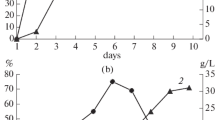Abstract
Basidiomycete fungus Serpula lacrymans is one of the most dangerous indoor fungus causing dry rot of timber. The physiology of this fungus deserves more attention as a basis for development of methods of dry rot treatment. We observed an increase in the freezing resistance of S. lacrymans after pre-cultivation of mycelia at elevated temperatures. To examine the biochemical mechanisms underlying this phenomenon the lipid composition and metabolite profiling of mycelia subjected to freezing and thawing were investigated. An analysis is made of the growth rate and metabolism of “daughter” cultures derived from a frozen mycelia. According to the results, sphingolipids and water-soluble metabolites such as mannitol, glycerol, sugar alcohols, some amino- and organic acids are able to function as protective compounds providing a cross-resistance between heat shock and freeze–thaw stress in S. lacrymans.



Similar content being viewed by others
References
Gabriel J, Svec K (2017) Occurrence of indoor wood decay basidiomycetes in Europe. Fungal Biol Rev 3:212–217
Schmidt O (2007) Indoor wood-decay basidiomycetes: damage, causal fungi, physiology, identification and characterization, prevention and control. Mycol Prog 6:261–279
Watkinson SC, Eastwood DC (2012) Serpula lacrymans, wood and buildings. Adv Appl Microbiol 78:121–149
Linde GA, Luciani A, Lopes AD, do Valle JS, Colauto NB (2018) Long-term cryopreservation of basidiomycetes. Braz J Microbiol 49:220–231
Panoff JM, Thammavongs B, Laplace JM, Hartke A, Boutibonnes P, Auffray Y (1995) Cryotolerance and cold adaptation in Lactococcus lactis subsp. lactis IL1403. Cryobiology 32:516–520
Thammavongs B, Panoff J-M, Gueguen M (2000) Phenotypic adaptation to freeze–thaw stress of the yeast-like fungus Geotrichum candidum. Int J Food Microbiol 60:99–105
Smith D (1982) Liquid nitrogen storage of fungi. Trans Br Mycol Soc 79:415–421
Park J-I, Grant CM, Attfield PV, Dawes IW (1997) The freeze-thaw stress response of the yeast Saccharomyces cerevisiae is growth phase specific and is controlled by nutritional state via the RAS-cyclic amp signal transduction pathway. Appl Environ Microbiol 63:3818–3824
Dubernet S, Panoff J-M, Thammavongs B, Gueguen M (2002) Nystatin and osmotica as chemical enhancers of the phenotypic adaptation to freeze–thaw stress in Geotrichum candidum ATCC 204307. Int J Food Microbiol 76:215–221
Lewis JG, Learmonth RP, Watson K (1995) Induction of heat, freezing and salt tolerance by heat and salt shock in Saccharomyces cerevisiae. Microbiology 141:687–694
Kowalsky LRZ, Kondo K, Inouye M (1995) Cold-shock induction of a family of TIP1-related proteins associated with the membrane in Saccharomyces cerevisiae. Mol Microbiol 15:341–353
Kotlova ER, Senik SV, Kücher T, Shavarda AL, Kiyashko AA, Psurtseva NV, Sinyutina NF, Zubarev RA (2009) Alterations in the composition of membrane glycero- and sphingolipids in the course of Flammulina velutipes surface culture development. Microbiology 78(2):193–201
Nichols BW (1963) Separation of the lipids of photosynthetic tissues: improvements in analysis by thin-layer chromatography. Biochim Biophys Acta 70:417–425
Benning C, Huang ZH, Gage DA (1995) Accumulation of a novel glycolipid and a betaine lipid in cell of Rhodobacter sphaeroides grown under phosphate limitation. Arch Biochem Biophys 317:103–111
R Core Team (2018) R: A language and environment for statistical computing. R Foundation for Statistical Computing, Vienna, Austria. https://www.R-project.org/
Stacklies W, Redestig H, Scholz M, Walther D, Selbig J (2007) pcaMethods-a bioconductor package providing PCA methods for incomplete data. Bioinformatics 23:1164–1167
Gu Z, Eils R, Schlesner M (2016) Complex heatmaps reveal patterns and correlations in multidimensional genomic data. Bioinformatics 32:2847–2849
Lu J, Xu Y, Wang J, Singer SD, Chen G (2020) The role of triacylglycerol in plant stress response. Plants 9:472
Tereshina VM, Memorskaya AS, Kotlova ER (2013) Lipid metabolism in Aspergillus niger under conditions of heat shock. Microbiology 82(5):542–546
Yanutsevich EA, Memorskaya AS, Groza NV, Kochkina GA, Tereshina VM (2014) Heat shock response in the thermophilic fungus Rhizomucor miehei. Microbiology 83(5):498–504
Tereshina VM, Memorskaya AS (2005) Adaptation of Flammulina velutipes to hypothermia in natural environments: the role of lipids and carbohydrates. Microbiology 74(3):279–283
Hazel JR (1995) Thermal adaptation in biological membranes: is homeoviscous adaptation the explanation? Annu Rev Physiol 57:19–42
McElhaney RN (1984) The Relationship between membrane lipid fluidity and phase state and the ability of bacteria and mycoplasmas to grow and survive at various temperatures. In: Kates M, Manson LA (eds) Biomembranes. Plenum Press, New York, pp 249–276
Lehnen M, Ebert BE, Blank LM (2019) Elevated temperatures do not trigger a conserved metabolic network response among thermotolerant yeasts. BMC Microbiol 19(1):100
Ruijter GJG, Bax M, Patel H, Flitter SJ, van de Vondervoort PJI, de Vries RP et al (2003) Mannitol is required for stress tolerance in Aspergillus niger conidiospores. Eukaryot Cell 2:690–698
Nissim I, Hardy M, Pleasure J, Nissim I, States B (1992) A mechanism of glycine and alanine cytoprotective action: stimulation of stress-induced HSP70 mRNA. Kidney Int 42(3):775–782
Nissim I, States B, Hardy M, Pleasure J, Nissim I (1993) Effect of glutamine on heat-shock-induced mRNA and stress proteins. J Cell Physiol 157(2):313–318
Pérez-Torres I, Zuniga-Munoz AM, Guarner-Lans V (2017) Beneficial effects of the amino acid glycine. Mini Rev Med Chem 17(1):15–32
Elbein AD, Pan YT, Pastuszak I, Carroll D (2003) New insights on trehalose: a multifunctional molecule. Glycobiology 13:17R-27R
Singer MA, Lindquist S (1998) Thermotolerance in Saccharomyces cerevesiae: the yin and yang of trehalose. TIB Tech 16:460–468
Thomashow MF (1999) Plant cold acclimation: freezing tolerance genes and regulatory mechanisms. Annu Rev Plant Physiol Plant Mol Biol 50:571–599
Kaul SC, Obuchi K, Iwahashi H, Komatsu Y (1992) Cryoprotection provided by heat shock treatment in Saccharomyces cerevisiae. Cell Mol Biol 38:135–143
Funding
Funding was provided by Institutional research project “Biodiversity, ecology, structural and functional features of fungi and fungus-like protists” АААА-А19-119020890079-6.
Author information
Authors and Affiliations
Corresponding author
Additional information
Publisher's Note
Springer Nature remains neutral with regard to jurisdictional claims in published maps and institutional affiliations.
Rights and permissions
About this article
Cite this article
Senik, S.V., Kolker, T.L., Kotlova, E.R. et al. Lipid and Metabolite Profiling of Serpula lacrymans Under Freezing Stress. Curr Microbiol 78, 961–966 (2021). https://doi.org/10.1007/s00284-021-02349-4
Received:
Accepted:
Published:
Issue Date:
DOI: https://doi.org/10.1007/s00284-021-02349-4




